Fecund Algorithms [at Anita Rogers Gallery] introduces a new collection of paintings in a range of unique materials including oil, graphite, and various metallic and florescent pigments on aluminum panels, many of which take years for the artist to complete. Titled with anagrammatic terms, the series Torso/ Roots grapples with the complex and inextricable relationships between the human body and the mind, the physical and the spiritual, and art, architecture and the natural world. The pieces, at once bold and rich with subtleties, are vertically structured and based on a grid derived from harmonic mathematical relationships. Due to the reflective and absorbent nature of the pigments the artist chooses, new details emerge from the works as they are viewed from different perspectives and at various times of day; in this way, every interaction with one of the panels is a new experience. The works demand a physical reaction from the viewer, keeping them consistently aware, awake and engaged.
Tag Archives: Anita Rogers Gallery
NY-ArtNews Reviews Joan Waltemath: Fecund Algorithms
Upon entering the open space of the Anita Rogers Gallery you are greeted with rectangular aluminum canvas’ that immediately draw your eye and are painted like multi-paneled grids. The subtly decadent, organized planes of color and texture serve as visual offsets and underline the surrounding architecture of the Anita Rogers Gallery. Both the rigorous lines of Piet Mondrian’s seminal paintings and the tempered emotive undertones of Agnes Martin’s work come to mind.
Waltemath’s paintings do not assault the space but complement and summarize it. The canvas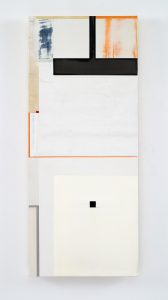 es’ precisely organized colors and textures create a prevailing mood of a restful oasis. The sumptuous dilapidation of the gallery walls and fixtures enhance this mood. On a recent trip to Washington D.C. surrounded by historic monuments and nature I felt the same sense of peace and contemplation. These paintings provide the mental space to think, contemplate, and consider. The rigidly organized lines and colors force the consciousness inward or similarly condense the surrounding space and architecture onto a single plane. As such the paintings are correspondingly simple and complex.
es’ precisely organized colors and textures create a prevailing mood of a restful oasis. The sumptuous dilapidation of the gallery walls and fixtures enhance this mood. On a recent trip to Washington D.C. surrounded by historic monuments and nature I felt the same sense of peace and contemplation. These paintings provide the mental space to think, contemplate, and consider. The rigidly organized lines and colors force the consciousness inward or similarly condense the surrounding space and architecture onto a single plane. As such the paintings are correspondingly simple and complex.
Juxtaposed to the paintings are smaller textile pieces Waltemath considers her “rest” pieces intended to break up the complexity of the paintings and provide an inviting tactility. The soft construct of these pieces provide a nice counterbalance to the paintings and provide a narrative as to how Waltemath may have arrived at her painting techniques. While it is my belief that good painting often deceptively hides the evidence of time, the textile pieces through their meticulously attended stitching, provide not only a rest for the eye but also a welcome relief in the revelation of the lovely preciseness, rigor, and disciplined labor that underpin the paintings on view.
Rather than lines that recede into the paintings at an angle creating the illusion of depth what happens(West 1 1,2,3,5,8…), creates a conceptual understanding of space through horizontal lines. Comparing Waltemath’s paintings in relation to depth, you could say that the amount of uninterrupted open space in what happens(West 1 1,2,3,5,8…), creates a greater depth than Waltemath’s interwoven (East 2 1,2,3,5,8…), which fragments and stratifies its plane. One could say then that these paintings act as windows or looking glasses to greater expanses, however what is depicted is an interior world, both of the viewer and the paintings’ surroundings. Another noteworthy element of the paintings are the specific materials used, graphite, zinc, bronze, lead, that bring to mind layered geological formations or the raw material of industrial spaces. Indeed taking the first analogy, one could analyze her paintings as cross sectional slices of stone compressed and combined with a richness of pure and impure minerals. These windows and geological slices attune the viewer to an interstitial space and perhaps a pataphsycial belief that all will work out as it should.
artnet Asks: Artist Joan Waltemath and the Secret Beauty in Math
Opening April 5 at Anita Rogers Gallery, “Fecund Algorithms” is the latest solo exhibition by Joan Waltemath. Grappling with the complex and often contradictory relationships between the body and mind, the artist’s abstract paintings look to mathematical equations for their harmonious and inventive grid-based compositions.
Waltemath is not only an artist, however: She is also known as an influential educator and a writer, having taught architecture for years at Cooper Union and serving as editor-at-large for the esteemed Brooklyn Rail since 2001. Here, she discusses her new work, the beauty in mathematics, and what to expect at her show.
What inspired you to create the Torso/Roots series?
I am intrigued watching people perform tasks they know by heart, observing movements that seem to stem from the corporeal, rather than being directed by the mind. I want to create something that speaks directly to the body that touches our movement in the way architecture does. The more all our devices assert their dominance over the mode of our communications, the more compelled I feel to explore the multi-faceted nature of perception. How the body knows things, remembers a thing is my tabula rasa.
Hamptons Art Hub’s “New Shows to Know” Features Joan Waltemath: Fecund Algorithms
SOHO — Anita Rogers Gallery: “Joan Waltemath: Fecund Algorithms”
April 5 through May 10, 2017
Opening Reception: Wednesday, April 5, at 6 p.m.
Joan Waltemath’s solo exhibition “Fecund Algorithms” at Anita Rogers Gallery will feature new paintings from her “Torso/Roots” series. The paintings, many of which took years to create, are made out of materials such as oil, graphite and metallic and fluorescent pigments on aluminum panels and were structured on harmonic mathematical relationships. Titled with anagrammatic terms, “Torso/ Roots” grapples with the complex and inextricable relationships between the human body and the mind, the physical and the spiritual, and art, architecture and the natural world.
Joan Waltemath, a New York-based painter, has shown work in New York, Chicago, Portland, Baltimore, London, Basel and Cologne and is in the collections of the Museum of Modern Art, the National Gallery of Art, the Hammer Museum and the Harvard University Art Museum, among others.
Gordon Moore on The Finch
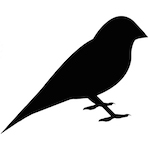 The collision and/or communion between repetition and randomness in the visual world is a perpetual source of interest for me. Just as what is regarded as “standard” I think of as being too formally familiar. Dichotomy and conflict create inventive dialectic. There is in this world a ubiquitous visual paradox which is a constant source of creative potential. As Oscar Wilde accurately put it: “The true mystery of the world is the VISIBLE not the INVISIBLE”. I wish to go there for a language. – Gordon Moore
The collision and/or communion between repetition and randomness in the visual world is a perpetual source of interest for me. Just as what is regarded as “standard” I think of as being too formally familiar. Dichotomy and conflict create inventive dialectic. There is in this world a ubiquitous visual paradox which is a constant source of creative potential. As Oscar Wilde accurately put it: “The true mystery of the world is the VISIBLE not the INVISIBLE”. I wish to go there for a language. – Gordon Moore
Gordon Moore: New Work Opens at Anita Rogers Gallery
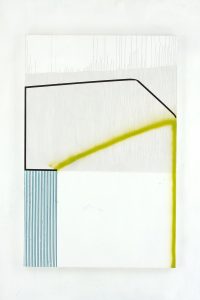 The collision and/or communion between repetition and randomness in the visual world is a perpetual source of interest for me. Just as what is regarded as “standard” I think of as being too formally familiar. Dichotomy and conflict create inventive dialectic. There is in this world a ubiquitous visual paradox which is a constant source of creative potential. As Oscar Wilde accurately put it: “The true mystery of the world is the VISIBLE not the INVISIBLE”. I wish to go there for a language.
The collision and/or communion between repetition and randomness in the visual world is a perpetual source of interest for me. Just as what is regarded as “standard” I think of as being too formally familiar. Dichotomy and conflict create inventive dialectic. There is in this world a ubiquitous visual paradox which is a constant source of creative potential. As Oscar Wilde accurately put it: “The true mystery of the world is the VISIBLE not the INVISIBLE”. I wish to go there for a language.
-Gordon Moore
Anita Rogers Gallery is thrilled to present an exhibition of new works on canvas and photo emulsion paper by the American painter, Gordon Moore. The exhibition will be on view February 15 – April 1, 2017 at 77 Mercer Street #2N, New York, NY.
In this exhibition Moore’s current work continues an interest in the dialogue he has developed over the past decade between the spontaneous flow of painterly liquids and the specific structural framework of his abstract configurations. The esoteric nature of abstraction offers an unlimited potential for invention. Using photo-emulsion paper as a ground for drawing, Moore embraces and encourages the imperfections inherent in the interaction between developer and emulsion. This in turn nurtures Moore’s large scale works on canvas which explore a similar approach to depth, dimension, balance and asymmetry. Moore’s pieces are exercises in asymmetrical equilibrium that challenge the viewers’ natural perceptions. The collection of works on view here are thoughtful meditations on connections and alignments – on the interaction between flatness and depth, deliberation and spontaneity, the real world and the painted world and finally between abstraction and figuration.
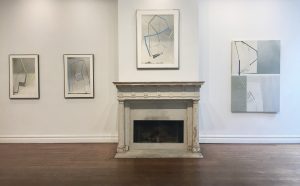 Born in Cherokee, IA, Moore received his undergraduate degree from the University of Washington, Seattle in 1970 and then went on to receive his MFA from Yale University in 1972. He has received numerous awards and grants including the National Endowment for the Arts-Visual Artists Fellowship, the Louis Comfort Tiffany Foundation Award in Painting, the Adolph and Ester Gottlieb Foundation Award in Painting, the Academy Award in Art from the American Academy of Arts and Letters, Pollock Krasner Foundation Grant and the New York Foundation for the Arts Fellowship. Moore’s work can be seen in the collections of the Museum of Fine Arts (Boston, MA), Yale University Art Gallery (CT), Baltimore Museum of Art (MD), General Electric Corporation (OH), the Krannert Art Museum (IL) and Kinkead Pavilion (IL).
Born in Cherokee, IA, Moore received his undergraduate degree from the University of Washington, Seattle in 1970 and then went on to receive his MFA from Yale University in 1972. He has received numerous awards and grants including the National Endowment for the Arts-Visual Artists Fellowship, the Louis Comfort Tiffany Foundation Award in Painting, the Adolph and Ester Gottlieb Foundation Award in Painting, the Academy Award in Art from the American Academy of Arts and Letters, Pollock Krasner Foundation Grant and the New York Foundation for the Arts Fellowship. Moore’s work can be seen in the collections of the Museum of Fine Arts (Boston, MA), Yale University Art Gallery (CT), Baltimore Museum of Art (MD), General Electric Corporation (OH), the Krannert Art Museum (IL) and Kinkead Pavilion (IL).
Steven Alexander Journal Highlights Tristan Barlow and Hans Neleman
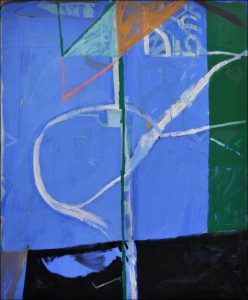 London based painter Tristan Barlow is in a two person show with Dutch-born photographer Hans Neleman at Anita Rogers in Soho. Both artists explore processes of accumulation and excavation of cultural imagery and sensual physical substance. Barlow employs layers of marks and shapes that gel into luscious intuitive abstractions that convey a dynamic sense of place. Neleman constructs framed assemblages with great attention to the nuances of mystery and meaning latent in his time-worn found materials and images.
London based painter Tristan Barlow is in a two person show with Dutch-born photographer Hans Neleman at Anita Rogers in Soho. Both artists explore processes of accumulation and excavation of cultural imagery and sensual physical substance. Barlow employs layers of marks and shapes that gel into luscious intuitive abstractions that convey a dynamic sense of place. Neleman constructs framed assemblages with great attention to the nuances of mystery and meaning latent in his time-worn found materials and images.
– STEVEN ALEXANDER
Taverna Rebetika 2017
On Saturday, January 28, Anita Rogers Gallery hosted TAVERNA REBETIKA, a special event celebrating Greece, life, music and art with traditional Rebetiko and Smyrnaiko.
The gallery was transformed into a 1930s style Greek taverna for this special evening. There was live Greek music from the 1930s, Greek food, unlimited wine and Greek dancing in a traditional setting. Anita sang with Rebetiko group “I Meraklides.” Works by Brice Marden, George Negroponte and Jack Martin Rogers were on view for the event, all whom are either Greek or painted in Greece.
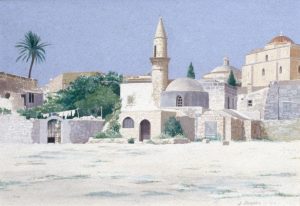
Painting by Jack Martin Rogers
Download short video of Taverna Rebetika.
Anita Rogers Gallery Named One of the Top Art Galleries in SoHo by TravelMag
ANITA ROGERS GALLERY
This hidden gem exhibits a wide range of emerging to mid-career artists in an elegant high-ceilinged space flooded in light, with an old-fashioned fireplace to boot. Highlights include the abstract minimalist paintings of George Negroponte on irregular pieces of cardboard. While they may appear slight at first, there’s a subtle beauty of geometric expression that shines through the longer you peer into these unique creations.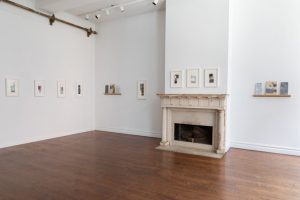
– CHRISTOPHER KOMPANEK, TRAVELMAG
View the full list on TravelMag.com
How an Art Library Is Changing Lives in L.A.
Interesting article from Artsy.Net:
In 2004, Dan McCleary’s mother passed away. “My parents were avid book readers and collectors of art books,” the artist told me. “So instead of buying flowers, I told everyone to buy me books.”
That was the early genesis for a library of art books that grew to become the core of Art Division, an L.A. nonprofit space that provides free art education to underserved young adults in the city’s MacArthur Park neighborhood. As word spread that McCleary was collecting books, more donations came in from friends and fellow artists. “Chris Burden heard about it, got in touch with me and said his mother had just passed away, and did I want her books?” McCleary recalls. “He had amazing art books from his mother’s library. That was one of the big donations right at the beginning.” Today, Art Division boasts an impressive collection of over 8,000 books. And it’s still growing.
In the early days, McCleary was working as Director of Art Programs at Heart of Los Angeles (HOLA), another nonprofit that primarily focused on enrichment programs for kids from younger age groups. Eventually, he founded Art Division in 2010 with help from Javier Carrillo, Maria Galicia, and Emmanuel Galvez. They took the more adult-oriented books from the collection they’d amassed at HOLA—with permission—and set up shop in a building in the primarily Latino neighborhood of MacArthur Park. McCleary geared the space towards young adults between 18 and 26 who were “not ready to go off and be full-blown adults” as he puts it, but who had graduated high school and found what miniscule access to arts training they had cut off.
The 10,000 book library is the “heart and soul” of Art Division. From there, the nonprofit offers a range of courses and access to arts materials, providing something of a “high-end Master’s program for inner-city young adults,” said McCleary. “We give them an in-depth training in the arts.” Art Division offers entirely free classes (semesters are roughly 12 weeks) in art history, painting, drawing, printmaking, creative writing, film, and more. Access to materials, like the classes themselves, is completely gratis. Students are also taken to L.A.’s numerous museums (MOCA is a 10-minute drive) to actually see the art they studied first hand—a kind of in-person education not available even to some full-time art history undergraduates at rural schools. But beyond access, Art Division is different than your normal art history course. The latter is “slide after slide and half the class falls asleep,” McCleary said. “The point is that we don’t do that. We take a good look at the actual books and go see the art.”
And, of course, anyone can visit Art Division and crack open one of the thousands of books on the shelves to guide their studies or develop their interests as they see fit. That openness and freedom is important to McCleary. Beyond the classes, Art Division serves as a space where residents can come to relax, foster ideas, and hone their art historical knowledge. “We’re open six days a week, from 11 a.m until 8 or 9 o’clock at night,” said McCleary. “People can come and eat, work in the library and do their homework, and also have access to a really great staff and faculty of artists.” The books range from monographs of individual artists to scholarly works on architecture, fashion, art therapy—the list goes on. Teachers integrate the books into their classes and if a student is researching a particular subject or artist, McCleary will make an effort to obtain the needed materials.
Read the full post on Artsy.Net